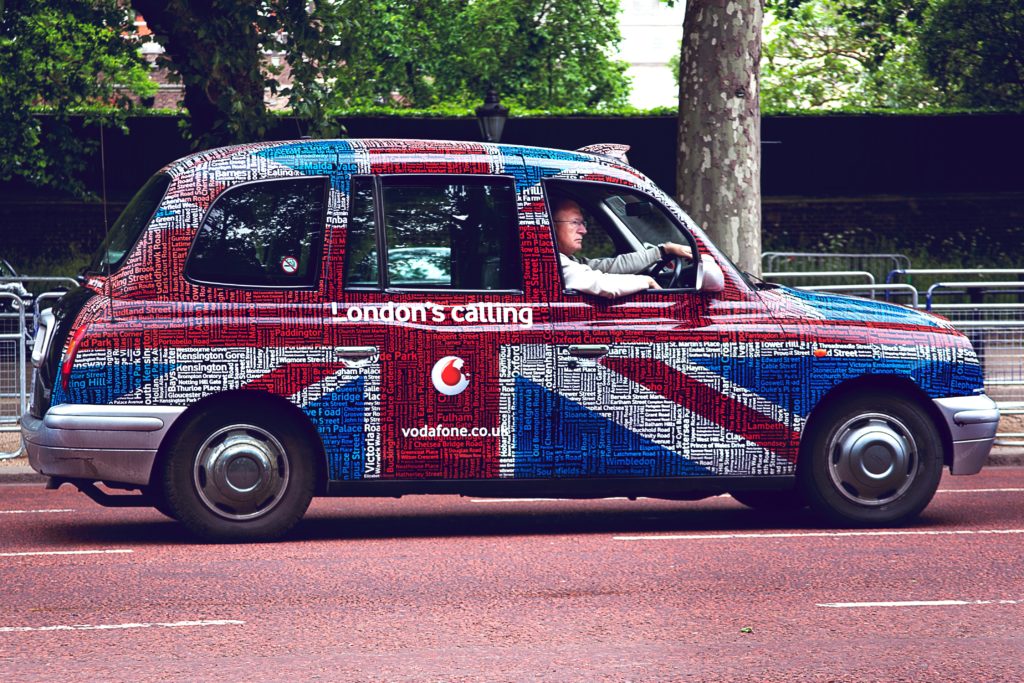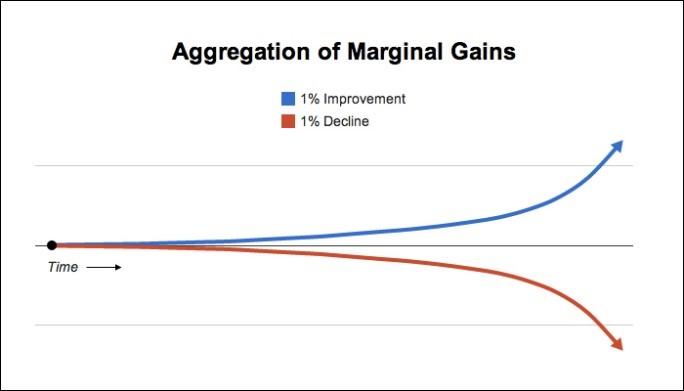 Book a 30 Minute
Book a 30 MinuteIntroduction Meeting

|
Getting your Trinity Audio player ready...
|
Change in all its forms has fascinated me for years but it’s the principles surrounding marginal gains that has my special attention. In this Ultimate Success Guide to Marginal Gains, I’ve collated the very best observations, comments, thought leadership, examples and education I’ve been able to find for you.
This guide includes everything to convince you, that marginal gains are the right strategy for your business.
Let’s get started…
From cycling to education; car making to holidays, people are finding that 1% certainly makes a big difference. But why is it such an interesting strategy for business.It simply means focusing on small changes to everything in the business; 1% at a time. There’s a time and a place for transformation change; a complete overhaul and a new way of doing everything but, its risky. Concentrate on making many 1%improvements and you’ll find the compound effect is huge and you avoided a major upheaval.
The theory of marginal gains goes way back, but perhaps Beijing Olympics 2008 was a new start, with London 2012 becoming the tipping point.

British Cycling was in a pickle. The now Sir Dave Brailsford arrived to head up and revive British cycling. He took the ailing British Cycling Federation from 2 bronze medals at the 1984 Atlanta Olympics to the fantastic medal haul of 8 gold, 2 silver and 2 bronze at London 2012 and 6 gold, 4 silver and 1 bronze in Rio 2016. He rightly deserves all the credit.
1% became the team mantra; all day every day. He understood that if you’re going to win you must have everything under control and working at its very best. ‘Very best’ only comes with continuous improvement (CI). All the time his concentration was on the small improvements every day; everywhere and anywhere: 1% at a time. And it worked – brilliantly.
In 2012 Sir Dave Brailsford explained the idea of marginal gains to the BBC. He said:
"The whole principle came from the idea that if you broke down everything you could think of, that goes into riding a bike, and then improved it by 1%, you will get a significant increase when you put them all together.
"There's fitness and conditioning, of course, but there are other things that might seem on the periphery, like sleeping in the right position,having the same pillow when you are away and training in different places.
"They're tiny things but if you clump them together it makes a big difference.”
This phenomenal success caught the eye of Cranfield Business School who published a paper, called The 15 Steps to Peak Performance which detailed the principle.
This is such an important strategy that I’d argue that every business regardless of size, industry or location must understand the 1% concept; embed and implement it across business operations. It is that important.
Whilst the principle is the same, it’s called different names: marginal gains, continuous improvement or Kaizen to name a few. Let’s make sure we understand the terminology.
The marginal gains theory is concerned with small incremental improvements in any process, which, when added together, make a significant improvement. Matthew Syed, author of Black Box Thinking wrote a viewpoint for the BBC about marginal gains. It’s a great read filled with references to speed eating,aviation and healthcare as well as a few cyclists!
The practice of Continuous Improvement (CI), sometimes called Continual Improvement, is the ongoing improvement of products,services or processes through incremental and breakthrough improvements. Because its continuous improvement its usually depicted as a circular flowchart sourced from High Jump.
Kaizen is Japanese for improvement and it means ‘change for the better’. It focuses on activities that continuously improve all functions,processes and employees. The theory is that by improving standardised activities and processes, Kaizen will eliminate waste. It was first used in Japanese businesses after WW2 influenced by American business and quality managers. Since then it’s gone global because employees at every level of the company combine their collective talents to create powerful improvements.

You might think 1% is too small a target for your business. You’ll be aiming much higher: 25% growth at least. But let me show you the magic that one cycling director uncovered to smash through their huge targets. 1+1+1= big improvements.
First, a question for you…..
How many times have you delayed an annual price increase because a 10% rise just seemed too much for customers to bear? No wonder it’s such a shock to your customers. But it’ll be an even greater shock to your business when you start losing money.
Instead, why not consider just a 1% price increase, say 4 times a year? Ah, you’re thinking, that’s just 4 %, but according to PWC;
“…. a 1% price increase typically delivers an 11%impact on profit . So, in volatile and competitive markets, it is more important than ever to give pricing the attention and focus it deserves.”
PWC has a detailed research paper & guide which covers this pricing challenge.
James Duval, writing for Customer Think says:
“In the world of business, the smallest changes and tweaks to existing models and approaches can be substantially more effective than large, disruptive ones in increasing revenue, changing direction, and even choosing an initial path for a start-up.”
That’s why the most successful businesses are the ones that make the smallest changes? They ignore the premise that ‘big changes = big results’.

So, why do we still believe that we must make big changes to get big results? If we want to lose a stone in weight, why do we focus on the ‘stone’ we have to lose rather than the 2lbs a week we need to shift over a 7-week period? 2lb is much easier compared to a stone; perhaps that’s why we fail so often; the goal is just too big, too daunting, too impossible… and so we give up.
The same applies in any business; big or small.
One of our clients bought products to resell to the public via their disruptive website. Every time they bought another batch of stock,they re-negotiated prices, asked for discounts or improved credit terms, free delivery and bonuses. They targeted a 1% positive benefit every time. More often than not they achieved the price they wanted to pay. But it’s not just about buying right….
All businessesare a collection of individual processes that fit together to deliver the product. It’s easier if you look at each process in turn; making small improvements to each process rather than changing the entire business in one go.
If you map each process, you’ll soon discover waste that can be eliminated; remove duplication, fill gaps and address automationthen you’ll find many 1% savings that will soon add up.
Big changes are so disruptive to daily operations –that’s why they usually fail. In a competitive market all business owners should be seeking out small measured improvements and changes to their product, service, delivery and processes rather than decide on massive disruptive change.
A much better strategy is to optimise a tweak rather than the game-changing ‘big idea’.
Google is a great example of a company that used small tweaks to existing ways of thinking and providing a service to become a business colossus. They’re now famous, and feared, algorithm updates are proof of their total focus on continuous improvement.
Apple are widely regarded to be one of the most innovative companies operating in the world today, and many of the company’s biggest hits are spectacular displays of the ‘tweak’ in action. The company has applied this mantra to everything it has done since. To paraphrase company CEO Tim Cook,
“Apple spend a lot of time making sure their great ideas are packaged inside other great ideas.”
Neither Apple nor Google reinvented the wheel. They just focused on improving it a little bit each time; tweaking existing systems to bring big benefits.
Anyone can do this.
You can do this.
It’s not difficult; it just requires commitment.

Ask yourself; ‘What can we do that the competition isn’t doing yet? What can other industries show you about improvements?
McLaren, the Formula One racing team is so good at this, that they help other industries to benefit from marginal gains. One such company was a toothpaste manufacturer.
You don’t have to be first; you just need to be better. Remember, it’s always the second mouse who gets the cheese.
Implementing small changes in strategy can make a big difference according to Marry Warner for Tweak Your Biz. She says;
“Big things come in small packages and lots of them! This is especially true for startups and small businesses that are very keen about increasing their profits and are ready to do anything for it. The only problem SMBs are unaware of is, most big things that really matter to business can be achieved just by changing a few small things in the work process and strategies”.
The article gives you some great ideas, although in my opinion each suggestion also adds complexity to the business; more things to keep track of and ultimately improve by 1%. She goes on to cover customer service improvements, payment and shipping options as well as discounts, deals and how to do it.
All good stuff but for me there should always be an improvement goal to reduce complexity by 1%. That could be reducing colour options, sizes,delivery charges, payment options etc. Marginal gains aren’t always achieved by adding more choice for customers. Removing waste and complexity; the KISS (keep it simple stupid) principle also brings huge rewards.
Marry is right, improving customer service by just 1% has a positive impact on your bottom line. Reducing the number of complaints, saves time and money so placing your focus firmly on reducing complaints is time well spent.
Improving product quality, thereby reducing the number of quality control issues will assist. Double checking orders, especially multi product orders before they are dispatched reduces errors, so does checking the shipping label is on the right box!
Paul Lemburg’s web blog way back in 2010, suggests that,
“making a series of small changes, consistently and over time, is the one, sure-fire, guaranteed way to insure your business makes you rich.”
Unfortunately, the link to the video post he mentions doesn’t appear to be connected anymore, but he encourages you to
“Implement something new every week – a little tweak, as often as you can manage.”
We’ve all heard the phrase ‘change for changes sake’. It’s too easy to make change after change after change until everything has changed beyond recognition. Customers don’t recognise you, staff are confused,suppliers mystified, and you’re exhausted! STOP.
No knee jerk reactions should ever be allowed in your business. Think about it, work it out. Ask yourself ‘how can I make ‘x’ better, quicker, cheaper, easier, more reliable, less complicated… etc.
Make time to consider options and then implement the right change. But don’t stop there; track the change, measure it, review it and stop or adjust it, if it isn’t working. It might only take one or two small changes to get your big difference instead of a big mess trying to make too many changes all at once.
In James Clear’s article on marginal gains he talks about the Aggregation of Marginal Gains; saying
“…improving by just 1% isn’t notable (and sometimes it isn’t even noticeable). But it can be just as meaningful, especially in the long run”.
James makes 2 important points. First is that marginal losses occur in the same wayas marginal gains and secondly the compound effect of not getting back on track quickly.
As the entrepreneur, Jim Rohn says:
“Success is a few simple disciplines, practised every day; while failures are simply a few errors in judgement, repeated every day.”
But beware, this pattern works just the same way in reverse. Instead of marginal gains you have marginal losses. If you find yourself stuck with marginal losses and poor results, it’s not because something happened overnight. It’s the sum of many small choices — a 1% decline here and there — that eventually leads to a big problem.

Inspiration for this image came from a graphic in The Slight Edge by Jeff Olson.
At the beginning, there isn’t a difference between making a choice that is 1% better or 1% worse; it won’t impact much today. But as time goes by, the small improvements or declines compound and soon there’s a big gap between company’s who make slightly better decisions daily and those who don’t. This is why small choices add up over the long-term even if there’s not much difference at the time.
Most people love to talk about success, but the truth is that most of the significant things in life aren’t stand-alone events,but rather the sum of all the moments when we chose to do things 1% better or 1%worse. Aggregating these marginal gains makes a difference.
James concludes his valuable link laden article with a reminder that,
“There is power in small wins and slow gains.”
You can’t eat an elephant in one go.
It’s just the same as writing my book, The Grown-Up Business or this paper – it just doesn’t happen in one go. I write the first draft, then I re-work it trying to make improvements each time. At some point I have to stop, or it won’t get published and then no one will read it. But if I were to keep reviewing it, I know that I would make improvements. When my book was published, I read it all and already have lots of sticky notes for improvements to go into the 2nd edition.

In Bill Marsh Jnr article, small wins, he relays a story about a writer who sets a target of 1000 words per day. The writer did this for 259 days and wrote enough content for 3 books. They were all published within a year and returned a tidy financial sum.
Bill’s point was that, had his friend set a target to write & publish 3 books in a year it probably wouldn’t have happened.
But as Bill said,
“… by focusing on small wins and slow gains, he accomplished far more than he ever thought possible in such a short time.”
You can only influence what happens in the future by what you do next. You can’t win a golf tournament on the first day but you can put yourself in a good position to win on the last day. The idea of mini targets, mini goals is one that is gaining traction with businesses. Achieve each mini goal and you’ll easily achieve the bigger target. And you get to celebrate a bit along the way too!
If you want to achieve big goals turn them into mini actions.
Want this = do that. Do that = achieve goal.
So, if I want to drop a dress size, that’s my goal. My actions might be; do 50 press-ups every day and don’t eat any cakes, sweets or chocolate! It might be run 3 miles 3 times a week and 15 minutes of Pilates every day. You get the idea, actions we can do, goals we can only achieve when we have done the actions.
When most businesses are looking for improvements, they usually focus too much on large, costly complex and transformational change programmes. They fail to seriously consider the positive impact that incremental change, over a sustained period, could have on a business.
DMW Group suggest in their article that,
“it is our experience that organisations frequently spend insufficient time working out what small changes can be made that, when built layer on layer, lead to significant improvements.” They also contend that even, “…if you are a top quartile performer already, it’s the marginal gains that ‘put you to the top of your game.”
Before you start aggregating your marginal gains you, as the business owner, must be prepared to drive this new way of operating right through the business. Your management team must be on-board and all employees engaged with enthusiasm, if you are to succeed.
You shouldn’t exclude any part of the business when seeking out marginal gains – it must be access all areas.
Companies that adopt marginal gains; 1% improvements as their business model and successfully drive this through see significant, positive and sustainable growth.
Our world has been and will remain, in a constant state of evolution and change. Some hugely disruptive, whilst others small, hardly distinguishable movements. There is no doubt that major change is hard to deal with and hence the recruitment industry does a thriving trade in supplying change managers to large organisations looking for radical change.
Incremental change, the 1% method doesn’t require the business to engage expensive change managers. It’s’ just the way that business happens around here. The new normal is seeking small improvements every day that add up to a bigger impact.
I’ve accumulated more than 100 marginal gains that you could implement that will make a positive difference. Here’s my Top 10:

People are a huge part of any business so a little improved performance by everyone will make a huge difference. In Richard Pearson's post on Marginal Gains, Noticeable Results for HR Reviewdetails how
“marginal gains work just as efficiently (effectively) in the HR department, concluding that a 24% increase in job satisfaction can be achieved.”

But, there’s no point dedicating time or effort to getting marginal gains if you don’t analyse and resolve inefficiencies within the team. Poor performance isn’t a consequence of one mistake but lots of small incorrect decisions over time. A bit like Chinese whispers….
It’s the constant stream of errors which increases the gap between you and better decision makers. Richard concludes,
“that the key to succeeding in business is no longer the grandiose and expensive changes, but rather it is the attention to and improvement of all the finite,day-to-day decisions that will create outstanding success.”
The team at fresh tilled soil share their own story about marginal gains and how they’ve applied it to their business; one step at a time.
“One of the constraints we’ve placed on ourselves is to remain at about 30 full-time people. That restriction means we must focus on other ways to grow value. The path we chose was to make as many small marginal gains as possible.Our belief was that the aggregate of these small gains would lead to a large overall gain for the business. We started this journey to making marginal gains with the knowledge that there are no silver bullets in business. There is hardly ever just one thing that improves your business. Success is an aggregate of many small things.”
Even American Express gets in on the 1% project suggesting 6 tiny business tweaks that pay off big time. They assert that it really is “the little things that make a big difference.”
Our clients’ experiences with 1% isn’t restricted to buying better or implementing price rises, they extend to every nook and cranny of the business and its operations.
It’s all about making minor adjustments to how you operate your business; one small one then another and another. Be careful, if the adjustments you’re making are the wrong ones you’ll soon be going in the wrong direction.
And if you are worried about the last Amex suggestion, ‘raise your prices’ then why not go for just 1% now and then another 1% in 3 months’ time, over and over again.
A client who was retailing product online focused on their purchasing. They set themselves a goal to buy each new batch of stock at a better price or with better terms than the last purchase. For example, their first purchase £5000 of stock was at £4.12 per unit, the second purchase of £8000 of stock was at £4.06 per unit. The third for £12000 had a unit cost of £3.99. They didn’t achieve a cost reduction every time, on occasion their credit terms were improved, or they were offered discounted stock items. They were extremely successful exiting the business after 22 months with a very nice price tag! Don’t just focus on the selling price, the buying price and the associated terms are also crucial if you’re going to make marginal gains.
Companies can grow exponentially by constantly implementing 1% improvement. Continuous improvement is a business model worth studying and replicating. Do something different and make money.
That’s how Lewis Howes started his 7-figure business. He simply began doing something to make some money to pay his rent. In Emma Johnson’s article for Forbes she tells Lewis’s story and demonstrates how the 1% principle can work, how Lewis went from living on his sisters couch to earning a $1M and how that ‘little something’ grew into a big business.
If you’ve a big goal, then start by breaking it down into much smaller pieces. Set smaller goals that can be easily achieved. Achieve each small goal and the big goal happens. You’ll have something to celebrate every week; momentum starts to build, and together with your enthusiasm, it builds into an unstoppable success machine.
In John Meyer’s article for Entrepreneur Blog he concludes that the most powerful innovation happens incrementally. In his own example he proves why marginal or incremental change – even just 1%, is worth pursuing. John said
“When my company cut our sluggish Monday morning meeting down from 30 minutes to 15 minutes and asked all employees to stand, we got everyone’s week off to a better start and saved $520 of billable time every single week.”

Odd isn’t it that 1% of your average working day is 14 minutes!
Making small changes is all well and good but you must make the right changes or risk spiraling out of control. John details exactly how to make sure you are implementing the right changes. Try these methods for identifying, testing and optimising.
Don’t wait until something is wrong before trying to fix it – be proactive find the problem now and make the improvements and move onto the next one. Once the problems are solved then optimise your business by making processes that already work, work even better.
Change shouldn’t be huge to make a difference; it’s the little things that really count.
Likewise, Jeff Olson author of The Slight Edge, advocates scrapping big targets in favour of small goals and details just how to do it in his article The Power of 1% and How to Boost Business Three-Fold in a Year. Essentially,we can only impact what happens in the future by what we do now. So as Jeff Haden in his article for Inc., 5 Incredibly Effective Ways to Work Smarter not Harder, says “focus only on today.”
In Jermaine Haughton’s piece for www.managers.org.uk he discusses how marginal gains can boost SME profits and says,
“Data analysis company Quantum Black consulted a large engineering multinational to introduce a series of small adjustments to its team composition, that were mostly in the 0.5%-to-1% improvement range. The process resulted in a 22% rise in productivity improvement and performance.”
The airline industry has taken the 1% principle to the heart of everything it does in the air.A 1% saving on the amount of airline fuel used resulted in thousands of pounds of savings. The Telegraph details lots of examples but here are a few to whet your appetite.
Iris.co.uk posted an article ‘Marginal Gains a Blueprint for the Best in the Business’ which like many others refers to Sir Dave Brailsford, but includes Sir Alex Ferguson too. They say,
“What is guaranteed to make a difference on game day is the extra 1% of effort expended on making improvements to multiple aspects of training, planning and preparation regimes.”
And that “…. gains were made in every conceivable department, no matter how minor they may have seemed. From the base fabric of a cyclist's skin suit to the recruitment of specialist podiatrists and ocular scientists as part of a sports science team, no stone was left unturned.”
Iris have a free(email required) sign up to 2 e-books; The Power of Marginal Gains and Evolving Marginal Gains from this article, albeit their sign up process is a little clunky to get through.
Wherever you search on the web for marginal gains you’ll find results for Kaizen too.
It’s a system that focusses on continuous improvement in quality, technology, processes, company culture, productivity, safety and leadership. It’s a methodology that makes changes and monitors results; similar to the Plan – Do – Check- Act (PDCA) Model
Joel Bradbury’s article for Graphic Products has a good overview of Kaizen; what it is, how it works and what are the benefits.
Whatever you may think, London 2012 did leave a legacy; marginal gains, continuous improvement and the 1% principle. The education community has embraced the Sir Dave Brailsford method. Even school kids know about marginal gains,and they’ll probably know more than you soon.In 2016 at the Rio Olympics the 1% principle proved successful once again.
Whether or not you watch sport, the 2016 Olympics demonstrated the phenomenal success of the 1% theory.Team GB achieved even more medals than London 2012 as more sporting bodies adopted the training method and 1% principle so successfully engineered by Sir Dave Brailsford and executed by British Cycling.
But 1% isn’t the preserve of sport; its being successfully implemented in many businesses with the same phenomenal success. I challenge you to shrink the target, change the mindset, make the changes and reap the rewards.
If you’d like to know more about the huge benefits that can be achieved by implementing the 1% method of marginal gains, then give me a call now on 07885 197364 or email me at shirley.mansfield@coachsme.co.ukto discover a much better business world.

1. Follow me on X / LinkedIn and let me know the business challenges keeping you awake at night that you want to solve. Click here to email. Connect with me, The Business Planning Coach on Facebook and Instagram.
2. Grab a copy of my book The Grown-Up Business (paperback and Kindle). Get the tools and inspiration you need to go to the next level of wealth.
3. Work with me on your growth business to overcome the blockages, hurdles & problems that are holding you back. Join the community, email me with Let’s Get Started in the subject line or book a 30 Discovery Meeting using Calendly
“If you run a business, then buy this book. Not tomorrow, today!”
~ Sam Carpenter Work The System
Tel: 07885 197 364
Email: shirley.mansfield@coachsme.co.uk
© 2024 CoachSME and Shirley Mansfield